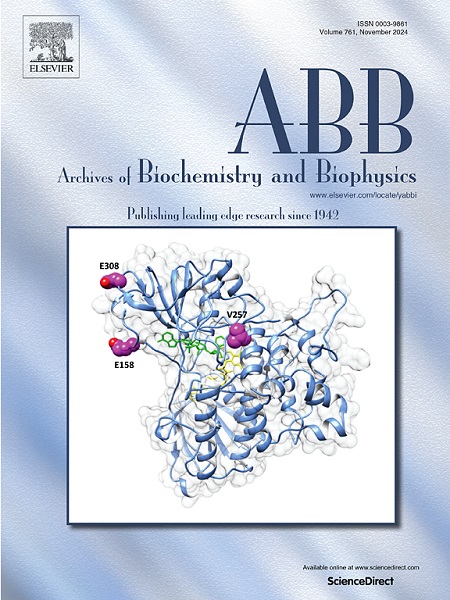米替福新和两性霉素 B 可诱导亚马逊利什曼原虫和利什曼原虫感染的巨噬细胞膜僵化
IF 3
3区 生物学
Q2 BIOCHEMISTRY & MOLECULAR BIOLOGY
引用次数: 0
摘要
通过自旋探针电子顺磁共振(EPR)光谱研究证实,用于治疗利什曼病的药物米特福辛(MTF)和两性霉素B (AmB)在抑制寄生虫生长的浓度下可诱导亚马逊利什曼原虫的膜刚性。值得注意的是,MTF引起的刚性不是由于其与膜的直接相互作用,因为较短的潜伏期反而增加了流动性。然而,短期药物暴露后的测量反映了可能的氧化应激完全发展之前的情况。AmB引起膜刚性,但浓度仅比暴露24 h后引起膜刚性的浓度高100倍。相反,在巨噬细胞中未观察到氧化应激诱导的膜刚性,这表明这些细胞产生的一氧化氮可能减轻氧化损伤。然而,这两种药物在感染利什曼原虫的巨噬细胞中,浓度略高于无尾线虫的IC50时,都能诱导明显的膜刚性。EPR数据进一步表明,即使没有药物暴露,氧化过程也可能发生在巨噬细胞-无马乳突系统的膜内。本研究还表明,这两种膜活性药物抗利什曼原虫活性的主要机制与它们对细胞膜的作用有关。膜改变可能导致离子失衡,进而破坏线粒体膜电位,从而增强活性氧(ROS)的形成。本文章由计算机程序翻译,如有差异,请以英文原文为准。

Miltefosine and amphoterin B induce membrane rigidity in Leishmania amazonensis and Leishmania-infected macrophages
Miltefosine (MTF) and amphotericin B (AmB), drugs approved for leishmaniasis treatment, induce membrane rigidity in Leishmania amazonensis at concentrations that inhibit parasite growth, as demonstrated through spin-probe electron paramagnetic resonance (EPR) spectroscopy. Notably, the rigidity induced by MTF is not due to its direct interaction with the membrane, as shorter incubation periods instead increase fluidity. However, measurements taken following short-term drug exposure reflect conditions before possible oxidative stress has fully developed. AmB causes membrane rigidity, but only at concentration 100 times higher than those causing rigidity after 24 h of exposure. In contrast, oxidative stress-induced membrane rigidity was not observed in macrophages, suggesting that nitric oxide production by these cells may mitigate oxidative damage. Both drugs, however, induced significant membrane rigidity in Leishmania-infected macrophages at concentrations slightly above the IC50 for amastigotes. EPR data further suggest that oxidative processes can occur within the membranes of the macrophage-amastigote system even without drug exposure. This study also suggests that the primary mechanisms underlying the antileishmanial activity of these two membrane-active drugs are associated with their effects on the cell membrane. Membrane alterations likely lead to ionic imbalances, which may, in turn, disrupt mitochondrial membrane potential and thereby enhance reactive oxygen species (ROS) formation.
求助全文
通过发布文献求助,成功后即可免费获取论文全文。
去求助
来源期刊

Archives of biochemistry and biophysics
生物-生化与分子生物学
CiteScore
7.40
自引率
0.00%
发文量
245
审稿时长
26 days
期刊介绍:
Archives of Biochemistry and Biophysics publishes quality original articles and reviews in the developing areas of biochemistry and biophysics.
Research Areas Include:
• Enzyme and protein structure, function, regulation. Folding, turnover, and post-translational processing
• Biological oxidations, free radical reactions, redox signaling, oxygenases, P450 reactions
• Signal transduction, receptors, membrane transport, intracellular signals. Cellular and integrated metabolism.
 求助内容:
求助内容: 应助结果提醒方式:
应助结果提醒方式:


